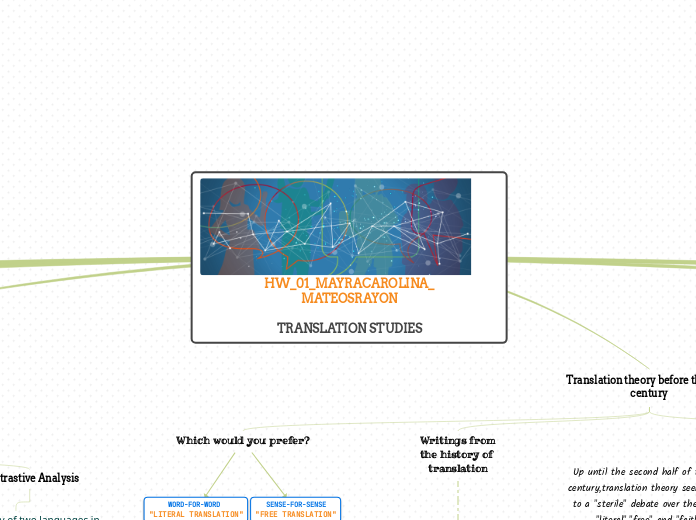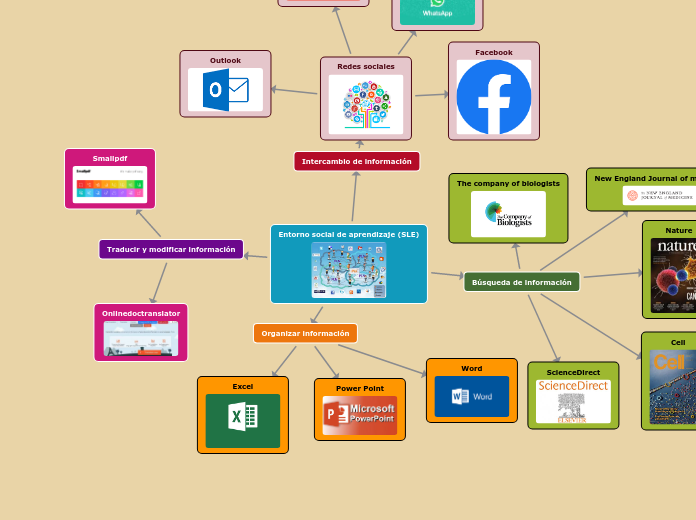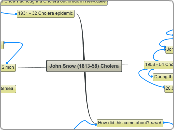Up until the second half of the 20th century,translation theory seemed locked to a "sterile" debate over the traid of "literal","free" and "faithful"
By 1988, Mary Snell- Hornby, in the first edition of her Translation Studies: An Integrated Approach, was writing that 'the demand that translation studies should be viewed as an independent discipline . . . has come from several quarters in recent years' (Snell-Hornby 1988).
Mona Baker Routledge Encyclopedia of Translation (1997a), talks effusively of the richness of the 'exciting new discipline, perhaps the discipline of the 1990s', bringing together scholars from a wide variety of often more traditional disciplines.
HW_01_MAYRACAROLINA_MATEOSRAYON
TRANSLATION STUDIES
HW_01_MAYRACAROLINA_MATEOSRAYÓN
Ethics in the Translation and Interpreting Curriculum.
Mona Baker
Article about the role of ethics in translation
Remarks and Recommendations
These are certainly challenges for educators. This particular topic deserves further exploration. As the yotube video says, we have to communicate meaning, improve skills, solve problems and most importantly do quality work.
Case Study: Introducing Ethics into the Curriculum at Leeds and University of East Anglia
Drugan and Megone (2011) offer one of the most detailed discussions of how ethics might be introduced in the translation and interpreting curriculum, with numerous examples of case studies and activities. Personal communication with the first author, Joanna Drugan (4 July 2013), confirms that at least some of the ideas outlined in this paper were put into practice at the University of Leeds
University of East Anglia
module entitled ‘Translation as a Profession’
Joanne Drugan
Next year, the ethics training here will sit in a Semester 2 module, Translation as a Profession. I’ll use a similar case study method, but this time only for translation students (about 20-30 per annum). The module is optional but is the basis for one of two ‘strands’ or pathways in the MA, running for the first time next year.
Technological Advances
Incorporating Ethics in the Curriculum
Building ethics into the translation curriculum, then, means opening up a space for critical reflection and training students to examine their values and the consequences of their behaviour, rather than encouraging them to constrain their ethical vision within the bounds of pre-established codes issued by any institution. To maintain a productive and reassuring link with the professional world of translation and interpreting, training must be based on authentic examples of actual translation and interpreting practice and must demonstrate to students that professional translators and interpreters themselves do reflect on ethical issues that arise from their positioning in an ever more challenging moral environment. This is important to challenge the widespread belief that to survive on the market and make a living, and to protect their own ‘integrity’, translators and interpreters have to learn to be apolitical and ‘impartial’ at all times.
Important resources.
Conceptual Tools
Deontological models
Teleological approaches
La amplia distinción entre enfoques deontológicos y teleológicos puede proporcionar un tipo de mapa conceptual y algún vocabulario para reflexionar sobre la base moral para tomar ciertas decisiones en lugar de otras en el contexto de la traducción y la interpretación. Puede ayudar a alertar a los estudiantes sobre sus propios valores y las rutas por las cuales deciden cómo deben actuar en general. Pero los contextos de la vida real pueden ser complejos y, a menudo, plantean múltiples consideraciones éticas. Baker se basa en un ejemplo discutido por Jeff McWhinney, ex director ejecutivo de la Asociación Británica de Sordos, en una presentación principal en la tercera conferencia anual de la Asociación Internacional de Traducción y Estudios Interculturales, Melbourne, 2009, para ilustrar este punto (Baker 2011 : 282):
Crowdsourcing is a potentially useful means of reducing the digital divide, but its ethics have been questioned from the perspective of its impact on the profession, as well as the nature of the relationship it configures between the translator and the corporate body that commissions and benefits from the translator’s labour. As the extract from the Twitter ‘Translation Agreement’ above makes clear, this relationship is problematic.
Newcomers to the field, including students of translation and interpreting, need to reflect on these developments and assume an ethically-informed position towards them.
The profession of translation and interpreting, including its various subsidiaries such as audiovisual translation and localisation, is now widely perceived to be under increased threat from new technologies and practices, most importantly machine translation and crowdsourcing.
The growth of activity in higher education reflects the fact that translation and interpreting are now increasingly recognised as vital activities and an indispensable part of the professional and social landscape
Professional Engagement with Ethics
Do you refuse translations on ethical, moral, political, or religious grounds?
Subtopic
We recently received the following email from a medical translator who has worked for a long-standing device client of ours:
“I’m not sure if you were aware, but there is a boycott in Mexico regarding travel, business, services, etc. related to Arizona and companies based there[3] It has come to my attention that [medical device company] is a company based in Arizona, U.S.A.
I offer my sincerest apologies, but I have to terminate my contribution to this project due to my collaboration with this boycott. My timing is highly unfortunate. I realize this will affect our working relationship. I hope you can understand that had I known this earlier, I would have informed you appropriately.”
Translation theory before the 20th century
Faithfulness, spirit and thruth
Flora Amos, in her Early Theories of Translation (1920), notes that early translators often differed considerably in the meaning they gave to terms such as “faithfulness” , “accuracy” and even the word “translation” itself.
JHON DRYDEN
Free approach to translation produced a reaction, notable from another English poet and translator.
Jhon Dryden reduces all translation to three categories
Word by word and line by line,translation which corresponds to literal translation.
Metaphrase
Translation with latitude where the author is kept in view by the translator, so as never to be lost, but his words are not so strictly followed as his sense; this involves more or less faithful or sense-for-sense translation.
Paraphrase
‘Forsaking’ both words and sense; this corresponds to Cowley’s very free translation and is more or less adaptation
Imitation
Writings from the history of translation
Cicero
St jerome
Dolet
Luther
Dryden
Tytler
Schleiermacher
They preferred to write sense-for-sense and were criticized for it.
Which would you prefer?
SENSE-FOR-SENSE
"FREE TRANSLATION"
WORD-FOR-WORD
"LITERAL TRANSLATION"
A brief history of the discipline
Contrastive Analysis
This is the study of two languages in contrast in
an attempt to identify general and specific differences between them.
Vinay and Darbelnet's (1958) Catford's (1965)
They overtly stated their aim of assisting translation research.
Comparative Literature
Running parallel to this approach was that of comparative literature, where literature is studied and compared transnationally and transculturally, necessitating the reading of some literature in translation. This would later link into the growth of courses of the cultural studies type
The Translation Workshop
Based on I. A. Richards's reading workshops and practical criticism approach that began in the 1920s , these translation workshops were intended as a platform for the introduction of new translations into the target culture and for the discussion of the finer principles
of the translation process and of understanding a text.
The direct method or communicative
approach
This approach places stress on students' natural capacity to learn language and attempts to replicate 'authentic' language learning conditions in the classroom.
This focus led to the abandoning of translation in language learning.
Grammar Translation Method
This method centred on the rote study of the grammatical rules and structures of the foreign language.
The Development of TS
Proliferation of conferences, books and journals on translation
1990s
Long-standing international translation studies journals such as Babel (the Netherlands), Meta (Canada) have now been joined by, amongst others, Across Languages and Cultures (Hungary), Literature in Translation (UK), Perspectives (France), Target (Israel/Belgium), The Translator (UK). Turjuman (Morocco).
Caminade and Pym (1995)
List at least 250 university-level bodies in over sixty countries offering four-year undergraduate degrees and/ or postgraduate courses in translation.
UK
The first specialized university postgraduate courses in interpreting and translating were set up in the 1960s. In the academic year 1999/2000
James S. Holmes
Poet and Translator
Translation Studies
This discipline is now known as "Translation Studies" thanks to important translator's researches James S. Holmes.
Holmes describes the discipline as being concerned with 'the complex of problems clustered round the phenomenon of translating .and translations'
Mona Baker
Mary Snell-Hornby
The concept of translation : It can refer to the general subject field, the product, ( the text that has been translated) or the process ( the act of producing the translation, known as translating).
Three categories of translation described by Roman Jakobson
Interlingual Translation or "rewording" : an interpretation of verbal sings by means of other signs of the same language
Interlingual Translation or "translation proper" : an interpretation of verbal sings by means of some other language.
Intersemiotic Translation or "transmutation" : an interpretation of verbal sings by means of signs of non-verbal sign system.
The role of translation studies :
The significance of translation in our daily life is extensively multidimensional.
What are the important aspects of translation? English is the most commonly spoken language, translation is more than just changing the words from one language to another.
Effective, efficient, and empathetic translation requires highly skilled practitioners.
Translation is necessary for the spread of information, knowledge, and ideas. For example: The Bible has been translated into at least 531 languages









